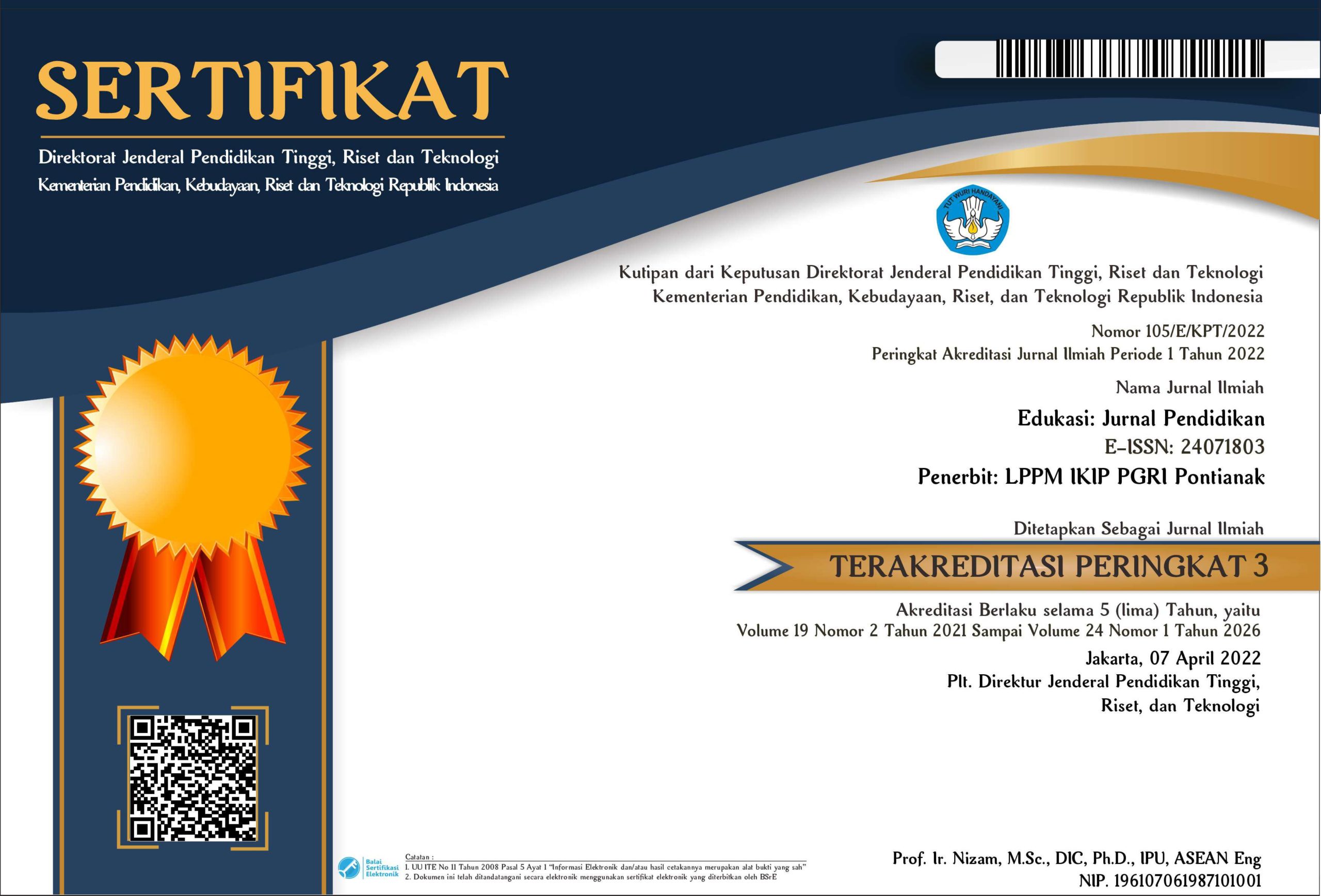Kesulitan Siswa Sekolah Menengah Pertama dalam Menyelesaikan Soal Matematika PISA-Like
DOI:
https://doi.org/10.31571/edukasi.v20i2.4781Keywords:
kesulitan siswa, literasi matematika, PISA-Like, student difficulties, mathematical literacyAbstract
Abstrak
PISA merupakan program internasional yang diselenggarakan oleh OECD dengan tujuan mengevaluasi kemampuan anak usia 15 tahun pada membaca, matematika, dan sains. Penelitian termasuk dalam penelitian kualitatif dengan tujuan untuk mendeskripsikan kesulitan siswa dalam menyelesaikan soal matematika PISA-Like. Sampel penelitian sebanyak 46 siswa SMP di Kota Surakarta yang dipilih dengan teknik simple random sampling. Instrumen penelitian terdiri dari tes berupa soal matematika PISA-Like dan nontes berupa angket. Analisis data dilakukan melalui reduksi data, penyajian data, verifikasi, dan penarikan kesimpulan. Hasil penelitian menunjukkan bahwa siswa mengalami kesulitan dalam menyelesaikan soal PISA-Like. Beberapa hal yang menyebabkan kesulitan siswa dalam menyelesaikan soal PISA-Like, yaitu: kurangnya pemahaman siswa terhadap soal yang diberikan; stimulus soal yang panjang dan rumit; serta tidak mengetahui konsep matematika yang akan digunakan. Kurangnya pemahaman siswa terhadap soal karena belum terbiasa menghadapi soal PISA sehingga mengalami kebingungan menggunakan konsep matematika.
Â
Â
Abstract
PISA is an international program organized by OECD aiming at evaluating the reading, mathematical, and science skills of students 15 years of age. This qualitative research attempted to describe students’ difficulty in solving PISA mathematic questions. To this end, forty-six junior high school students in Surakarta were involved with simple random sampling. The instruments in this research consisted of test instruments in the form of PISA-Like math problems and nontest instruments in the form of questionnaires. Data analysis was carried out through data reduction, data presentation, verification, and drawing conclusions. The results showed that students had difficulty solving PISA-Like questions. Several factors were found to account for students’ difficulty in solving Pisa-Like questions, including their poor understanding of the question; the long and complex stimulus of the question; and their lack of knowledge of the mathematical concept to be used. Students’ poor understanding of the question was particularly attributed to their unfamiliarity with questions, causing them to be confused about the mathematical concept to use.
Downloads
References
Charmila, N., Zulkardi, Z., & Darmawijoyo, D. (2016). Pengembangan Soal Matematika Model PISA menggunakan Konteks Jambi. Jurnal Penelitian dan Evaluasi Pendidikan, 20(2), 198-207. https://doi.org/10.21831/pep.v20i2.7444.
Dayona, G., & Zulkardi, Z. (2019). Student’s Mathematics Literacy Skills in Solving of PISA Type Problems Financial Context. Journal of Physics: Conference Series, 1315(2019), 1-6. https://doi.org/10.1088/1742-6596/1315/1/012013.
Fazzilah, E., Effendi, K. N. S., & Marlina, R. (2020). Analisis Kesalahan Siswa dalam Menyelesaikan Soal PISA Konten Uncertainty dan Data. Jurnal Cendekia : Jurnal Pendidikan Matematika, 4(2), 1034-1043. https://doi.org/10.31004/cendekia.v4i2.306.
Febrianti, P., & Nurjanah, N. (2022). Kesulitan Siswa SMP dalam Menyelesaikan Soal PISA 2021. Transformasi: Jurnal Pendidikan Matematika dan Matematika, 6(1), 13-24. https://doi.org/10.36526/tr.v%vi%i.1664.
Haara, F. O., Bolstad, O. H., & Jenssen, E. S. (2017). Research on Mathematical Literacy in Schools – Aim, Approach and Attention. European Journal of Science and Mathematics Education, 5(3), 285-313. https://doi.org/10.30935/scimath/9512.
Hwang, J., & Ham, Y. (2021). Relationship between Mathematical Literacy and Opportunity to Learn with Different Types of Mathematical Tasks. Journal on Mathematics Education, 12(2), 199-222. https://doi.org/10.22342/JME.12.2.13625.199-222.
Janah, S. R., Suyitno, H., & Rosyida, I. (2019). Pentingnya Literasi Matematika dan Berpikir Kritis Matematis dalam Menghadapi Abad ke-21. PRISMA, Prosiding Seminar Nasional Matematika 2 Tahun 2019.
Jannah, R. D., Putri, R. I. I., & Zulkardi, Z. (2019). Soft Tennis and Volleyball Contexts in Asian Games for PISA-Like Mathematics Problems. Journal on Mathematics Education, 10(1), 157-170. https://doi.org/10.22342/jme.10.1.5248.157-170.
Johar, R. (2012). Domain Soal PISA untuk Literasi Matematika. Jurnal Peluang, 1(1), 30-41.
Kementerian Pendidikan dan Kebudayaan. (2019). Pendidikan di Indonesia: Belajar dari Hasil PISA 2018. Jakarta: Pusat Penilaian Pendidikan Balitbang Kemendikbud.
Kurniasih, R., & Sujadi, I. (2017). Probabilistic Learning in Junior High School: Investigation of Student Probabilistic Thinking Levels. Journal of Physics: Conference Series, 895(2017), 1-7. https://doi.org/10.1088/1742-6596/895/1/012028.
Kurniawan, A., Setiawan, D., & Hidayat, W. (2019). Analisis Kemampuan Pemecahan Masalah Matematis Siswa SMP Berbantuan Soal Kontekstual pada Materi Bangun Ruang Sisi Datar. JPMI – Jurnal Pembelajaran Matematika Inovatif, 2(5), 271-282.
Masjaya, M., & Wardono, W. (2018). Pentingnya Kemampuan Literasi Matematika untuk Menumbuhkan Kemampuan Koneksi Matematika dalam Meningkatkan SDM. PRISMA, Prosiding Seminar Nasional Matematika 1 Tahun 2018.
Miles, M. B., & Huberman, A. M. (1994). Qualitative Data Analysis: An Expanded Sourcebook. London: SAGE.
Munayati, Z., Zulkardi, Z., & Santoso, B. (2015). Kajian Soal Buku Teks Matematika Kelas X Kurikulum 2013 Menggunakan Framework PISA. Jurnal Pendidikan Matematika, 9(2), 188-206. https://doi.org/10.22342/jpm.9.2.2161.188%20-%20206.
Mutia, & Effendi, K. N. S. (2019). Analisis Kemampuan Literasi Matematika Siswa SMP pada Soal Serupa PISA Konten Uncertainty and Data. Prosiding Seminar Nasional Matematika dan Pendidikan Matematika Sesiomadika Tahun 2019.
OECD. (2019a). PISA 2018 Assessment and Analytical Framework. Paris: OECD Publishing.
OECD. (2019b). PISA 2018 Results (Volume 1): What Students Know and Can Do. Paris: OECD Publishing.
Putra, Y. Y., & Vebrian, R. (2020). Literasi Matematika (Mathematical Literacy): Soal Matematika Model PISA Menggunakan Konteks Bangka Belitung. Yogyakarta: Deepublish.
Putrawangsa, S., & Hasanah, U. (2022). Analisis Capaian Siswa Indonesia pada PISA dan Urgensi Kurikulum Berorientasi Literasi dan Numerasi. Edupedika: Jurnal Studi Pendidikan dan Pembelajaran, 1(1), 1-12.
Simalango, M. M., Darmawijoyo, D., & Aisyah, N. (2018). Kesulitan Siswa dalam Menyelesaikan Soal-Soal PISA pada Konten Change and Relationship Level 4, 5, dan 6 di SMP N 1 Indralaya. Jurnal Pendidikan Matematika, 12(1), 43-58.
Stacey, K. (2015). The International Assessment of Mathematical Literacy: PISA 2012 Framework and Items. In S.-J. Cho (Ed.), Selected Regular Lectures from the 12th International Congress of Mathematical Education. Heidelberg: Springer. https://doi.org/10.1007/978-3-319-17187-6_43.
Stacey, K., & Turner, R. (2015). The Evolution and Key Concepts of the PISA Mathematics Frameworks. In K. Stacey & R. Turner (Eds.), Assessing Mathematical Literacy: The PISA Experience. Heidelberg: Springer. https://doi.org/10.1007/978-3-319-10121-7_1.
Thomson, S., Hillman, K., & DeBortoli, L. (2013). A Teacher’s Guide to PISA Mathematical Literacy. Victoria: ACER Press.
Vebrian, R., Putra, Y. Y., & Saraswati, S. (2022). Respon Siswa dalam Menyelesaikan Soal Literasi Matematika pada Konteks Bangka Belitung. Inovasi Matematika (Inomatika), 4(1), 11-18. https://doi.org/10.35438/inomatika.v4i1.302.
Wilkens, H. J. (2011). Textbook Approval Systems and the Program for International Assessment (PISA) Results: A Preliminary Analysis. IARTEM E-Journal, 4(2), 63-74. https://doi.org/10.21344/iartem.v4i2.777.
Zahid, M. Z. (2020). Telaah Kerangka Kerja PISA 2021: Era Integrasi Computational Thinking dalam Bidang Matematika. PRISMA, Prosiding Seminar Nasional Matematika 3 Tahun 2020.
Downloads
Published
How to Cite
Issue
Section
License
Authors who publish in this journal agree to the following terms:
- Authors retain copyright and grant the journal the right of first publication with the work simultaneously licensed under a Creative Commons Attribution License (CC-BY-NC) that allows others to share the work with an acknowledgment of the work's authorship and initial publication in this journal.
- Authors are able to enter into separate, additional contractual arrangements for the non-exclusive distribution of the journal's published version of the work (e.g., post it to an institutional repository or publish it in a book), with an acknowledgment of its initial publication in this journal.
- Authors are permitted and encouraged to post their work online (e.g., in institutional repositories or on their website) prior to and during the submission process, as it can lead to productive exchanges, as well as earlier and greater citation of published work.

 Download: 235
Download: 235


















